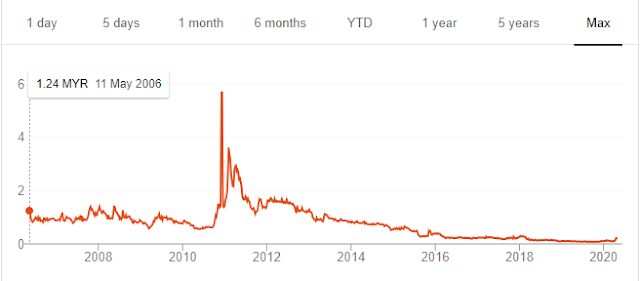Do you ever think why is this happening?
In technical analysis, one of the main pillar is market moves in trend.
From this aspect, we need to know market is uptrend, downtrend or sideway.
Why many people do well in up market?
Because during up market, up space is more than down space.
Figure 1
Red colour vertical line represent the down movement price distance.
During uptrend, up movement price distance is MORE THAN down movement price distance.
Green line is LONGER than Red line.
While for down market, down space is more than up space.
Figure 2
Green line SHORTER than Red line.
When you understand the characteristics of trend, then you can save lots of money.
Next let's see Good signal vs Bad signal.
During uptrend, many indicator give good signal and good entry.
Below example is used the most widely used indicator RSI.
Chart 1
For chart 1, RSI given 3 oversold signals if buy at that moment which are 100% winning rate as after entered position price start to move up.
In uptrend, you can blindly follow the indicator buy signal and mostly can earn profit without much problems.
This is because up space more than down space.
However when come to downtrend market, indicator buy signal can be a nightmare.
Chart 2
In this downtrend chart, RSI got 8 oversold signals. If we followed all these buy signals, got 5 signals after entered position price still moving down and some of them evening move down steeply.
3 of 8 buy signals can earn profit.
5 of 8 buy signals is Bad signal or so called FAKE SIGNAL which can make you lose money.
Therefore, many buy signals from indicators work well in uptrend but not in downtrend.
Therefore, many buy signals from indicators work well in uptrend but not in downtrend.
If you know when to buy and when NOT TO BUY, your stock return would be awesome.
Learn how to see the trend and follow the trend.
Hope this can help you improve your stock return on investment and avoid the TRAP.
To join our telegram channel, click below link
https://t.me/MasketeerTafaInvest
Like us on FB:
https://www.facebook.com/MasketeerTafaInvest/
Thank you for your reading.
Have a nice day.
Disclaimer:
Learn how to see the trend and follow the trend.
Hope this can help you improve your stock return on investment and avoid the TRAP.
To join our telegram channel, click below link
https://t.me/MasketeerTafaInvest
Like us on FB:
https://www.facebook.com/MasketeerTafaInvest/
Thank you for your reading.
Have a nice day.
Disclaimer:
All posts and documents submitted by the Admin in this blog are solely for open discussion and education purposes only. All recommendations and opinion provided by the Admin are solely for your consideration only and you should exercise your own judgement in forming your own investment decision(s). Please also be informed that all kind of investments have risks and we recommend you to conduct sufficient searches for information in addition to referring our recommendations and/or opinion herein, prior to making any investment decision.
You should take full responsibility of your investment decision(s) and we accept no liability whatsoever for any direct or consequential loss arising from any use of our recommendations and/or opinion provided herein or any solicitations of an offer to buy or sell any securities. Comments and opinions forwarded/shared/provided by members/followers/readers of this blog do not belong to Admin and we take no responsibility of such.











